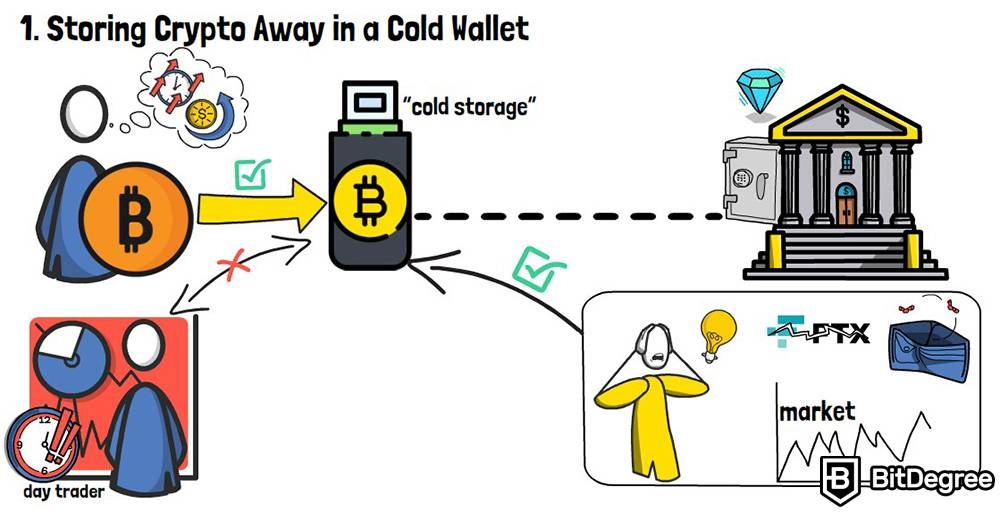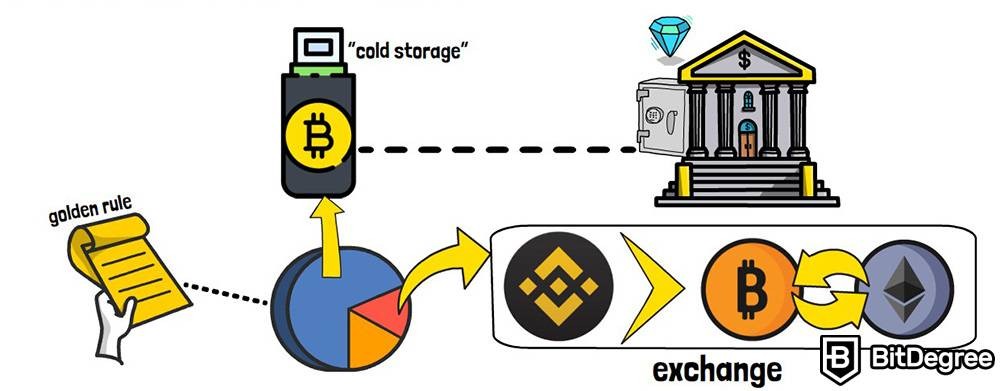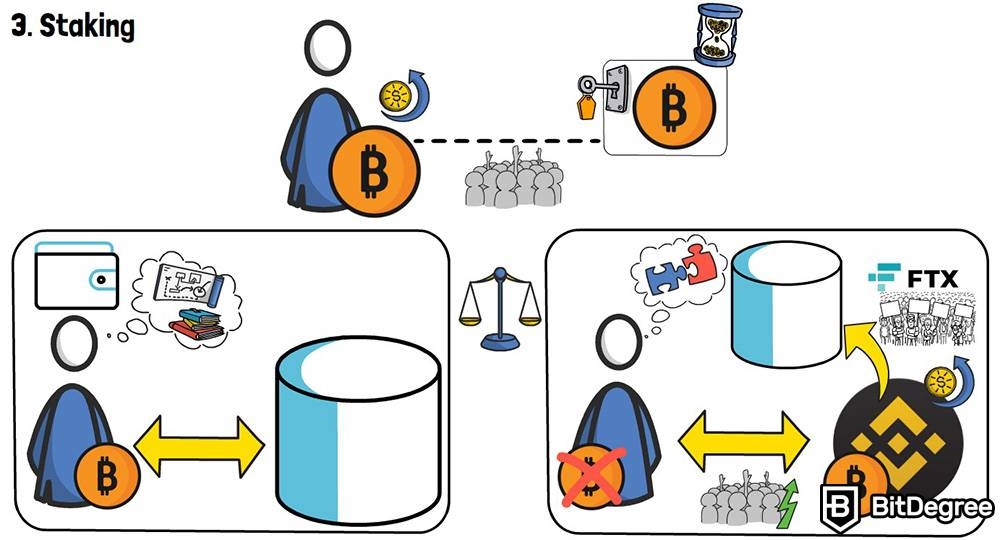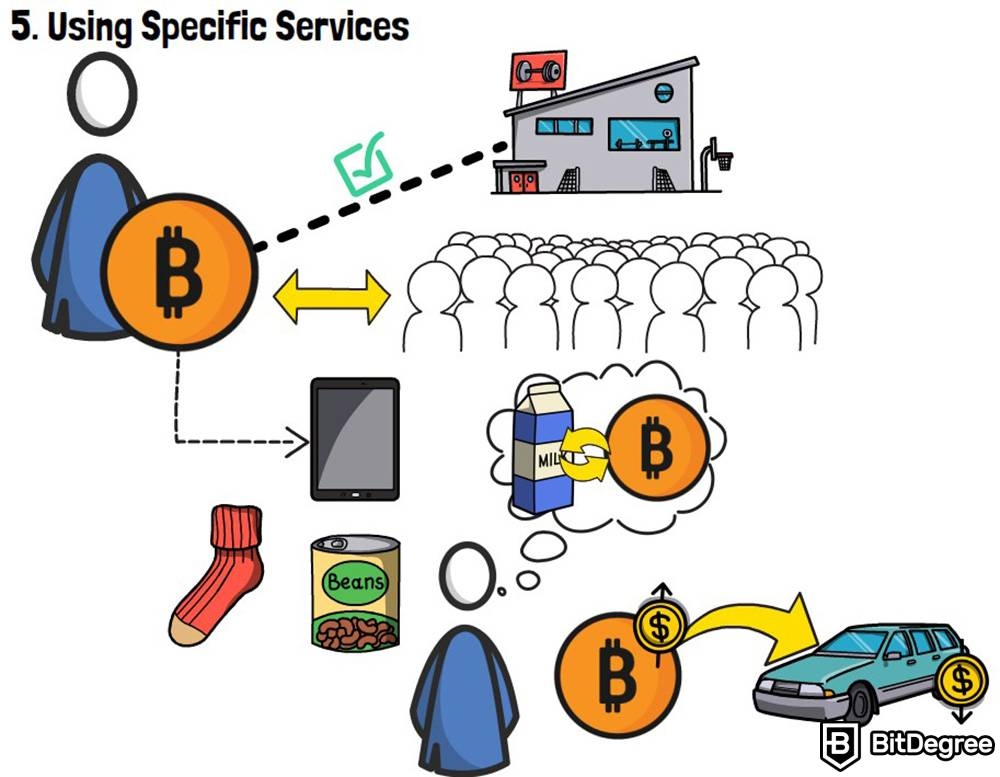You’ve Got Crypto: What Can You Do With It?
In this section, we’re going to talk about how to use cryptocurrency, once you already own it!
Owning crypto is a very exciting prospect! In the previous sections of this Crypto 101 Handbook, we’ve covered buying, selling, trading, swapping, and dealing with cryptocurrencies, in general. However, perhaps you’ve caught yourself wondering - what else can I do with Bitcoin, and other cryptocurrencies, too?
Well, once you get yourself some crypto assets, a whole new world of possibilities opens up, potential activity-wise. All that’s left to do is for you to weigh all of your options, and pick the best one!
In this section, we’re going to talk about how to use cryptocurrencies, and what can you do with your crypto. Specifically, we’ll cover the 5 most notable concepts and activities that you can participate in, with your crypto assets, and discuss their pros and cons, too.
Let’s get to it!

Video Explainer
Video Explainer: You’ve Got Crypto: What Can You Do With It?
Reading is not your thing? Watch the "You’ve Got Crypto: What Can You Do With It?" video explainer
How to Use Crypto? 5 Rewarding Strategies Explained (Animated)


Storing Crypto Away in a Cold Wallet
So, the very first thing that you can do with your cryptocurrencies is actually the most straightforward of the bunch, as well - store them away, in a cold wallet device.

Cold wallets are special, secure hardware devices that allow you to store your crypto, usually for a longer period of time. Think of these wallets as those little safe deposit boxes that you can rent, at your local bank, and store some valuable items in. It’s really the crypto equivalent of that!
The so-called “cold storage” is actually a very popular concept, within the crypto space. With the market being so volatile, still, and multiple high-tier exchanges and other crypto services going under thanks to one scandal after the other, people are looking at alternative ways of storing and securing their assets - cold wallets are the obvious answer, for most!
Now, admittedly, it’s also not something that will fit every single person looking at how to use crypto. Let’s say that you’re a day trader - someone who is constantly trading cryptocurrencies, and trying to “time the market”, so to speak. In a situation like this, keeping your cryptocurrencies in cold wallets might not be very convenient!
On the flip side, if you plan to hold the crypto that you’ve bought for a long time, as a long-term investment, and don’t really care about how to use Bitcoin to buy things, then cold wallets are certainly your best friend. The best example I can think of is this - imagine that you’ve just bought an old, vintage car. It’s absolutely gorgeous, and without a single scratch or dent in sight.
If you plan to keep that car for a few years, as an investment, and then sell it when its price appreciates, you’d probably store it in a designated garage, and wrap it up with multiple layers of protective materials. On the flip side, if you actually plan to drive the car, then unwrapping it every single time would simply be, well… Inconvenient!

The golden rule within the industry is pretty simple - you should store the majority of your assets in cold wallets, while keeping only a small amount on an exchange. This way, you’ll be able to buy, sell, and trade cryptocurrencies as you please, while the bulk of your investment stays safe and sound within a hardware wallet.
Trading Your Crypto
Of course, all of what I’ve just told you only works if you’re in it for the long term. That might not be your goal - instead, you might want to actively trade your assets!
This is the second activity of how to use Bitcoin, or any other crypto - trading. Admittedly, this is really an umbrella term - “trading” could mean everything from active day trading, where you flip crypto assets tens or hundreds of times per day, as well as passive trading, every few weeks, when you see an opportunity to make a potential profit.
It’s actually probably the most popular activity that people choose to participate in, with their cryptos! Once you have bought the coins and tokens that you want, a whole new world of opportunities opens up to you.
In order to start trading, however, you’ll need to spend a lot of time figuring out the intricacies of the market, as well as deciding on your tools, too. For example, will you perform all of your trades on centralized exchanges, or will you transfer your funds to a third-party wallet, and use the services of DEXs - decentralized exchange platforms?
What about taxes - that’s another headache to sort out, as well! Don’t worry, though - if you feel like trading is the path that you want to take, but are confused about where to start, there are dedicated sections covering both CEXs & DEXs, as well as crypto taxes, on this Crypto 101 Handbook - check them out, before you start trading!
Staking
Moving on, the third activity that you can participate in with your newly-acquired crypto assets is staking.

Now, staking is a whole separate can of worms, in itself. However, it’s also a super-popular method of how to use Bitcoin (and other cryptos) to make money, strictly for the fact that you are able to earn a passive interest on the cryptocurrency that you hold.
If you’re looking to get into staking, there are a couple of things that you need to figure out, beforehand. First, there are two types of staking - one where you directly interact with a specific staking pool, and another, when you stake crypto on an exchange platform.
Naturally, both have their pros and cons, as well. In the first scenario, you can stake your crypto on a pool of your choice, and do so from a designated wallet that you own. This method, however, is a bit complex, and you need to have a pretty decent understanding of staking, in general, in order to do everything properly.
Staking crypto on exchange platforms is becoming more and more popular, as time goes on. While it’s super-convenient, and you can find some great interest rates with the asset of your choice, some people avoid this form of staking due to the fact that you have to keep your assets on an exchange. With the multiple controversies that many exchange platforms find themselves in, you can probably see their point.
Then, you should also know that not all cryptocurrencies can be “staked”, the traditional way. If you already own some crypto, you can just utilize a single simple google search, and find out if your coin or token is “stakeable”. If you’re looking at what you can do with crypto, are interested in staking, but don’t have any assets yet, then proper research is warranted - take the time, and look into the coins that will both bring the best staking profits, and provide the least volatility, market-wise!
Investing Into Different Projects
The penultimate method of how to use cryptocurrencies involves investing in different crypto-native projects.

At first glance, this might look a bit confusing - doesn’t buying crypto constitute as “investing in a project”? And, yes - oftentimes, if you purchase a crypto asset, you’re directly or indirectly investing into the underlying platform that stands behind that project.
That being said, however, some projects only allow you to invest in them via crypto - meaning, you can’t use fiat (or, traditional, government-issued) money to invest, and must instead use some popular cryptocurrency.
This is especially true if you’re looking to back newly-launched projects. Visiting the official websites of such platforms, you’ll notice that investors can acquire said project tokens by trading them for ETH, USDT, or any other popular cryptocurrency, often on a decentralized exchange.
It’s a tad bit of a complicated process, I admit. However, if you’re looking to invest in specific projects, you would likely take the time and study them in-depth - this would, naturally, involve their token acquisition methods, too!
Using Specific Services
Last but not least, the fifth way of how to use crypto is, admittedly, rather expansive - you can use your crypto coins and tokens to pay for certain goods and services!

If you’ve ever wondered how to use Bitcoin to buy things, or even about what can you buy with Bitcoin, in general, this is probably the route that you’ll want to take. As crypto is becoming increasingly more adopted by the day, more and more traditional services offer payment options with crypto coins and tokens.
Services are just one part of the deal, though - the “what can you buy with cryptocurrency?” list extends to different products, as well! Nowadays, you might find shops that accept crypto payments, and deal in electronics, food items, clothing, and everything in between!
It’s worth mentioning that some people might find this method of how to use crypto a bit counterintuitive, since you would use a theoretically appreciating asset to purchase depreciating products. In other words, why would you buy a used car with your BTC coins, if the car will lose value, while BTC would likely grow and become more valuable, with time?
This argument is mostly popular with people who consider themselves investors, however, and who are looking to gain some monetary benefits from the space. If that’s not what you’re about, and you’re excited to purchase everyday items with cryptocurrency, keep in mind that, with time, the list of options is getting progressively bigger!
This wraps up the list of the main use cases of crypto assets. Don't forget to check other sections on this Crypto 101 Handbook if you want to become a real crypto expert!










